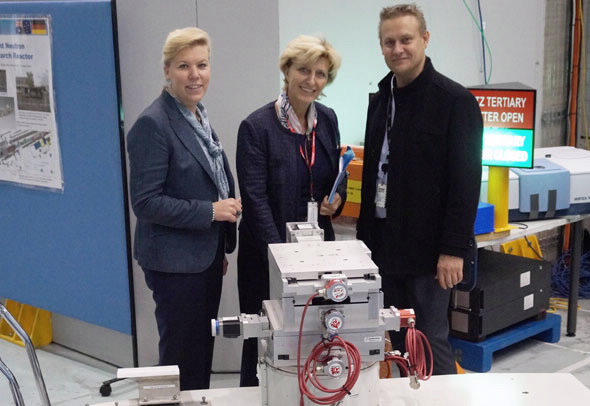 |
| (Left to right) Dr Simone Richter, Group Executive, Nuclear Science Technology & Landmark Infrastructure, Dr Anna Prinz, Ambassador of the Federal Republic of Germany and Dr Jamie Schulz, Leader of the Australian Centre for Neutron Scattering |
Dr Anna Prinz, the Ambassador of Federal Republic of Germany visited ANSTO on 2 June for discussions and a tour of the suite of neutron instruments, which includes the newly donated neutron reflectometer, SPATZ.
ANSTO negotiated the transfer of the instrument from the BER-II Research Reactor at Helmholtz-Zentrum Berlin (HZB) in 2015 and renewed a MOU for scientific collaboration with the renowned German research organisation in 2016.
A small team at the Australian Centre for Neutron Scattering has begun the painstaking assembly of the instrument, which has 257 parts and weighs more than 29 tonnes, in the Neutron Guide Hall. It arrived from Germany in February this year.
SPATZ, which will utilise neutrons from OPAL’s high-flux cold-neutron source, will be used for a wide range of applications in biomedicine, energy, and materials science. It will accommodate a range of sample environments, including cryomagnets.
Dr Simone Richter, Group Executive, Nuclear Science Technology and Landmark Infrastructure, and Dr Jamie Schulz, Leader of the Australian Centre for Neutron Scattering and Dr Anton LeBrun, Instrument Scientist who is the project manager for the construction of SPATZ, accompanied Dr Prinz on the tour.
“We were delighted that Ambassador Prinz was able to travel from Canberra to our site to see progress on the assembly of the instrument, which made a significant contribution to soft matter research, especially solid-liquid interfaces, in Germany,” said Dr Richter.
“We fully expect SPATZ to be used widely because of the great demand for neutron reflectometry and the instrument’s capacity for simultaneous infrared spectroscopy.”
SPATZ is planned to be available to users in late 2018 and a contingent of researchers from HZB will perform the first experiments.
Published: 05/06/2017


